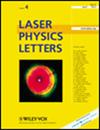计算高效的自适应优化矢量方法参数,用于光学相干弹性成像中的相敏应变估算
IF 1.4
4区 物理与天体物理
Q3 OPTICS
引用次数: 0
摘要
本文介绍了一种自动自适应优化相敏光学相干断层扫描(OCT)应变估计的新方法。更具体地说,本文侧重于使用矢量法优化应变估算,其中 OCT 信号被视为复平面上的矢量。在相位敏感光学相干弹性成像中,组织应变是从初始组织和变形组织的复值扫描之间的帧间相位变化中提取的。这种相位变化与帧间散射体的位移成正比,并与初始 OCT 扫描和复值共轭变形扫描的逐像素乘积的参数相对应。OCT 扫描中固有的测量噪声和所谓的 "斑点噪声 "会导致通过这种乘法得到的衍生扫描结果质量下降。为了减轻噪声的影响,通常会在一定窗口内对导出扫描中的复值像素振幅进行平均。帧间应变是通过估计帧间相位差的梯度得出的。噪声对应变估计的影响也可以通过增大估计相位差梯度的尺度来降低。然而,选择过大的窗口进行初步平均可能会严重扭曲重建的应变分布。同样,梯度估算的尺度过大也可能导致估算的应变幅度甚至符号出现误差(因为可能存在相位缠绕)。因此,对应变估计参数进行适当的自适应选择可以大大提高应变估计的质量。在此,我们提出了一种统一的方法,用于自适应选择平均窗口大小和梯度估计尺度,而这两种参数最初是分开考虑的。新方法在计算上有所简化,但应变估计质量却大致相同,模拟和实验 OCT 数据均证明了这一点。本文章由计算机程序翻译,如有差异,请以英文原文为准。
Computationally efficient adaptive optimization of vector-method parameters for phase-sensitive strain estimation in optical coherence elastography
A new method for automatic adaptive optimization of strain estimation in phase-sensitive optical coherence tomography (OCT) is introduced. More specifically, this paper focuses on optimizing the estimation of strain using the vector method, in which OCT signals are treated as vectors in the complex plane. In phase-sensitive optical coherence elastography, the tissue strain is extracted from the interframe phase variation between the complex-valued scans acquired for the initial and deformed tissue. This phase variation is proportional to interframe displacements of scatterers and corresponds to the argument of the pixel-by-pixel product of the initial OCT scan and complex-conjugate deformed scan. Measurement noises and the so-called ‘speckle noise’ that are intrinsic to OCT scans cause degradation of the derived scan obtained by such multiplication. To mitigate the noise influence, complex-valued pixel amplitudes in the derived scan are usually averaged over a certain window. The interframe strain is found by estimating the gradient of the interframe phase difference. The noise influence on the strain estimation can also be reduced by increasing the scale over which the phase-variation gradient is estimated. However, choosing a too large window for preliminary averaging may significantly distort the reconstructed strain distribution. Similarly, a too large scale for gradient estimation may also cause errors in the estimated-strain magnitude and even its sign (because of possible phase wrapping). Therefore, appropriately performed adaptive choice of the strain-estimation parameters can greatly improve the quality of strain estimation. Here, we present a unified approach for adaptive choice of both the averaging-window size and gradient-estimation scale that were initially considered separately. The new method is computationally simplified but enables approximately the same strain-estimation quality, as demonstrated using both simulated and experimental OCT data.
求助全文
通过发布文献求助,成功后即可免费获取论文全文。
去求助
来源期刊

Laser Physics Letters
物理-仪器仪表
CiteScore
3.30
自引率
11.80%
发文量
174
审稿时长
2.4 months
期刊介绍:
Laser Physics Letters encompasses all aspects of laser physics sciences including, inter alia, spectroscopy, quantum electronics, quantum optics, quantum electrodynamics, nonlinear optics, atom optics, quantum computation, quantum information processing and storage, fiber optics and their applications in chemistry, biology, engineering and medicine.
The full list of subject areas covered is as follows:
-physics of lasers-
fibre optics and fibre lasers-
quantum optics and quantum information science-
ultrafast optics and strong-field physics-
nonlinear optics-
physics of cold trapped atoms-
laser methods in chemistry, biology, medicine and ecology-
laser spectroscopy-
novel laser materials and lasers-
optics of nanomaterials-
interaction of laser radiation with matter-
laser interaction with solids-
photonics
 求助内容:
求助内容: 应助结果提醒方式:
应助结果提醒方式:


